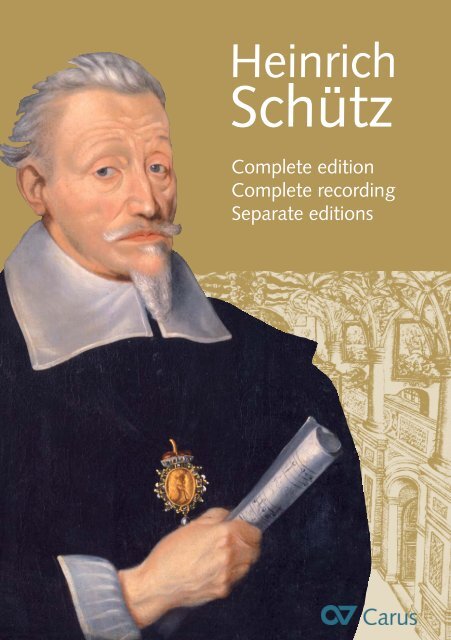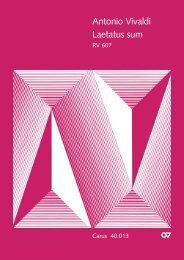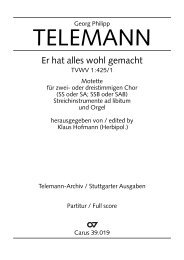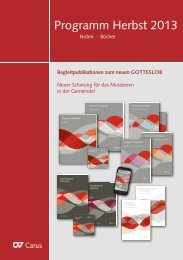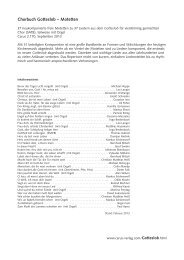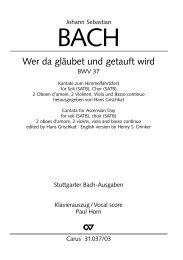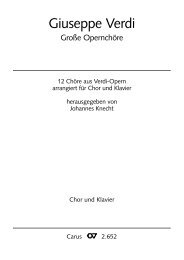Complete edition - Carus-Verlag
Complete edition - Carus-Verlag
Complete edition - Carus-Verlag
- No tags were found...
You also want an ePaper? Increase the reach of your titles
YUMPU automatically turns print PDFs into web optimized ePapers that Google loves.
HeinrichSchütz<strong>Complete</strong> <strong>edition</strong><strong>Complete</strong> recordingSeparate <strong>edition</strong>s
2 BiographyHeinrich Schütz (1585–1672) is regarded asthe first German musician of European stature. Hespent his youth in Weißenfels (Saxony) where he receiveda comprehensive education at the “Mauritianum”of the Landgrave Moritz of Hessen-Kassel. In1608 he began to study law in Marburg but abandonedthis course in 1609 and with the Landgrave’ssupport began to study composition in Venice withGiobanni Gabrieli, the organist of St. Mark’s Cathedral.His “apprentice piece” was the collection ofItalienischen Madrigale, published as Opus 1 inVenice in 1611.In 1613 Schütz returned to Kassel but just two yearslater he was lured away by Elector Johann Georg I ofSaxony to the court at Dresden as organist andDirector of Music. Here he held the position of Hofkapellmeisterfrom 1617 until his death (from 1656under Elector Johann Georg II).Prior to 1631, before the Thirty Years’ War reachedSaxony, Schütz composed important large-scaleworks using opulent instrumental and choral resources:the Psalmen Davids (published 1619), the Auferstehungshistorie(1623), the Latin CantionesSacrae (1625), the Psalter collection based on poeticadaptations of the psalms by the Leipzig the -ology professor Cornelius Becker (1628), as well asthe first volume of Symphoniae sacrae, which waspublished in Venice during Schütz’s second visit toItaly in 1629. In addition to these large collectionsSchütz composed many independent compositions,although only a few of them have survived.In the years of deprivation during the third phase ofthe Thirty Years’ War Schütz composed not only theKleine geistliche Konzerte (published in 1636 and1639) but also the Musikalischen Exequien (pub -lished in 1636) for Heinrich Posthumus Reuß inGera, who was in the strictest sense Schütz’s sovereign.It is an extraordinary funereal work both in the conceptionof the text and in its compositional style.Twice Schütz resided temporarily at the court of theDanish King in Copenhagen (in 1633–1635 and1642–1644). It was during his second stay that hecomposed the second volume of Symphoniaesacrae, which in contrast to the Latin texts of thefirst volume contains solo concerti with obbligatoinstruments and is based on German biblical texts(published in 1647).In spite of the decline of the Electoral Saxon Hof -kapelle, Schütz produced further collections, withwhich his reputation reached its height in Germanyand northern Europe: the collection of motets GeistlicheChormusik (Dresden, 1648) and the third vol -ume of Symphoniae sacrae (1650), again based onGerman texts and with which he intended to end hiscareer as Kapellmeister. This was however not to be,and it was only under the young Elector JohannGeorg II that Schütz was finally granted his wish toretire.The printed collections which the composer himselfinitiated represent only a portion of his completeopus; individual works appear within manuscript collectionswhich also include works by other compos -ers, while other of his works have survived only ashandwritten manuscripts (among these are alsovariants of works already printed), and much hasbeen lost.Schütz’s impressive late works, handed down pri -marily as manuscripts, begin with the Weihnachtshistorie(Christmas story) (1660, partly published in1664); followed by the Die Sieben Worte (TheSeven Last Words, probably composed in 1662), thethree a-cappella passions of St. Luke, St. John andSt. Matthew (1665/66) and in 1671, a year beforehis death, his Swansong, an extensive double-choirmotet based on Psalms 100 and 119 with theGerman Magnificat, with which he ended hiscompositional career.<strong>Carus</strong> 99.070/10.Deutscher Katalog erhältlich: <strong>Carus</strong> 99.070Editorial deadline: 11/2012Prices are subject to change. Errors excepted.<strong>Carus</strong>-<strong>Verlag</strong> StuttgartSielminger Straße 51D-70771 Leinfelden EchterdingenTelefon +49 711-797 330-0Fax +49 711-797 330-29e-mail: sales@carus-verlag.comwww.carus-verlag.com
Heinrich Schütz and <strong>Carus</strong> 3Heinrich Schütz and <strong>Carus</strong>2017 marks the 500th anniversary of MartinLuther’s posting of the 95 Theses to the church doorat Wittenberg, with which the Reformation in Germanyand Protestant church music began. HeinrichSchütz was the first Protestant church musician ofEuropean stature. This is reason enough for <strong>Carus</strong> tocombine the publication of the <strong>Complete</strong> Edition ofthe works of Heinrich Schütz with an internationally,highly regarded <strong>Complete</strong> Recording of his worksby the Dresdner Kammerchor under the direction ofHans-Christoph Rademann.In 1992 the Stuttgart Schütz Edition, the <strong>edition</strong> ofthe complete works of Heinrich Schütz, was takenover by <strong>Carus</strong>-<strong>Verlag</strong>, which has continued to pub -lish it since then. It is a complete <strong>edition</strong> founded ona critical examination of the sources which presentstoday’s users an unproblematic, legible rendering ofthe music. In contrast to other Schütz <strong>edition</strong>s theworks are presented in their original keys and ranges,i.e., they are edited untransposed. All editorial ad -ditions or suggestions are indicated diacritically. Thevolumes include all essential information concerningthe history of the works, their transmission, perform -ance practice and liturgical function. Original clefs,as well as the ranges of the vocal parts and theupper instrumental parts are prefixed to the firstbrace of the score.The music of Heinrich Schütz, especiallyhis Geistliche Chormusik 1648 has been a» part of our lives for many years. Especiallyfascinating is the fact that Schütz is not only amaster of the relationship between words andtones, but also that his works are always pleasantto sing, thus they were composed to suit thehuman voice. Moreover, his music possesses anobel aesthetic in form and structure. Our latestdiscovery is Schütz’s setting of Psalm 116, Das istmir lieb.Calmus EnsembleRembrandt: Portrait of a musician, probably Schütz.Oil on canvas, 1633. <strong>Carus</strong> 40.399/10, postcardThe Stuttgart Schütz Edition is being published incooperation with the renowned Heinrich-Schütz-Archiv of the Hochshule für Musik Dresden. Editorswho are experienced musicologists and knowlegeablein performance practice have been engaged forthe Edition. In the future one volume will be pub -lished each year.Subscription: A complete subscription will receive a20% discount off the retail price (see p. 8).www.carus-verlag.com/Schuetz.html
4 Overview of worksOverview of works<strong>Complete</strong> <strong>edition</strong> · <strong>Complete</strong> recording · Separate <strong>edition</strong>sA detailed overview of all <strong>edition</strong>s with evaluation scores, pages of music, sound samples and currentprices is available on our website at www.carus-verlag.com/Schuetz.html.Italienische Madrigale SWV 1–19Coro SSATB (Nr. 1–18), Coro SATB/SATB (Nr. 19)<strong>Carus</strong> 20.901, <strong>Complete</strong> <strong>edition</strong>, vol. 1ed. S. Schmalzried (1984), 98.00 €Separate <strong>edition</strong>s available <strong>Complete</strong> recording, vol. 2Psalmen Davids SWV 22–47Motets and concertos for eight and more voiceswith Bc<strong>Complete</strong> <strong>edition</strong>, vols. 2 & 3 (in prep.)Separate <strong>edition</strong>s available <strong>Complete</strong> recording, vol. 7 (in prep.)Auferstehungshistorie SWV 50Evangelist (T), 9 voices (Fav SSSAATTBarB), Bc,[8 Instr]<strong>Carus</strong> 20.904, <strong>Complete</strong> <strong>edition</strong>, vol. 4ed. G. Graulich (1986), 78.00 €Separate <strong>edition</strong> with performance materialavailable»For choirs who wish to become familiarwith the music of Schütz in just a short timeI recommend the four-voice MagnificatMeine Seele erhebt den Herrn SWV 426, from theZwölf geistliche Gesänge. In terms of the individualvoices the treatment of melody and range ofthe voices (soprano d 1 -e 2 , alto g-a 1 , tenor d-e 1 ,bass G-c 1 ) makes the Magnificat pleasant to sing.With its easily comprehensible imitation betweenthe four parts the musical structure is laid out in adiscreet polyphonic manner, between which thelayered homophonic sections regularly arrive atpoints of rest. Changes of meter enliven themusic, but they are not complicated. Readily understandableto the ears of choir and public alikeare the many musical interpretations of wordswhich are created by means of simple motives.”Kay Johannsen, Music Director of the StuttgartStiftskircheCantiones sacrae SWV 53–924 voices, Bc<strong>Carus</strong> 20.905, <strong>Complete</strong> <strong>edition</strong>, vol. 5ed. U. Wolf (in prep., 2013) <strong>Complete</strong> recording, vol. 5Psalmen Davids SWV 97–256Becker-Psalter. Coro SATB<strong>Complete</strong> <strong>edition</strong>, vol. 6 (in prep.)A selected <strong>edition</strong> with 37 psalm settings isavailable as well as many psalm settings inseparate <strong>edition</strong>sSymphoniae sacrae I SWV 257–27620 Latin sacred concerts for three to six voices(1–4 voices, obblig. instruments), Bc<strong>Carus</strong> 20.907, <strong>Complete</strong> <strong>edition</strong>, vol. 7ed. S. Schmalzried (1996), 198.00 €Separate <strong>edition</strong>s with performance materialavailableMusikalische Exequien I–III SWV 279–281Funeral music in three parts for six, eight andmore voices with BcFav SSATTBB, Cap SATB/SATB, Bc, [8 Instr]<strong>Carus</strong> 20.908, <strong>Complete</strong> <strong>edition</strong>, vol. 8ed. G. Graulich (1973), 68.00 €Separate <strong>edition</strong> with performance materialavailable <strong>Complete</strong> recording, vol. 3Kleine geistliche Konzerte, Teil 1 SWV 282–3051–5 voices, Bc<strong>Carus</strong> 20.909, <strong>Complete</strong> <strong>edition</strong>, vol. 9ed. L. Rémy (in prep.)Separate <strong>edition</strong>s available <strong>Complete</strong> recording, vol. 8 (in prep.)Kleine geistliche Konzerte, Teil 2 SWV 306–3371–5 voices, Bc<strong>Complete</strong> <strong>edition</strong>, vol. 10 (in prep.)Separate <strong>edition</strong>s available
Overview of works 5Symphoniae sacrae II SWV 341–36727 German sacred concerts for one to threevoices, 2 instruments, Bc<strong>Carus</strong> 20.911, <strong>Complete</strong> <strong>edition</strong>, vol. 11ed. Konrad Küster (2012), 198.00 €Separate <strong>edition</strong>s with performance materialin preparation (2013)Geistliche Chormusik 1648 SWV 369–39729 motets for five to seven voices (instrumentsand Bc ad lib.)<strong>Complete</strong> <strong>edition</strong>, vol. 12 (in prep.)Separate <strong>edition</strong>s with performance materialavailable <strong>Complete</strong> recording, vol. 1Symphoniae sacrae III SWV 398–41821 German sacred concerts for three to six voices,2 instruments, Bc<strong>Complete</strong> <strong>edition</strong>, vol. 13 & 14 (in prep.)Separate <strong>edition</strong>s with performance materialavailableZwölf geistliche Gesänge SWV 420–4314 voices (instruments, Bc ad lib.)<strong>Carus</strong> 20.915, <strong>Complete</strong> <strong>edition</strong>, vol. 15ed. G. Graulich (1971), 88.00 €Separate <strong>edition</strong>s with performance materialavailable <strong>Complete</strong> recording, vol. 4Weihnachtshistorie SWV 435Fav SSAATTBBB, 2 Vl, 2 Vga, 2 Blfl, Fg, 2 Tr,2 Trb, Bc, [Cap SATB, 4 Vga] / 45 min<strong>Complete</strong> <strong>edition</strong>, vol. 16 (in prep.)Separate <strong>edition</strong> with performance materialavailable»Ten times Schütz repeats Job’s affirmationIch weiß, dass mein Erlöser lebt (SWV393), almost as a mantra, and always withsimilar melodic and harmonic progressions thatalso imprint every word. In the high and lowchoirs he contrasts earthly life to the life of thehereafter, until the outer voices move towardseach other, with the worlds combining and promisingus redemption. Since the piece is primarilyhomophonic and the individual voices is lie withina very comfortable range, in spite of its sevenparts, this piece is suitable as an introduction toSchütz’s great motets and also as preparation forthe melodic and thematic connection which appearin his Exequien.sirventes berlinDie Sieben Worte SWV 478Fav SATTB, 5 Instr, Bc, [Cap SATTB] / 12 min <strong>Complete</strong> recording, vol. 6 (in prep.)Matthäuspassion · St. Matthew Passion SWV 479Fav SATTB, Coro SATB / 50 minLukaspassion · St. Luke Passion SWV 480Fav SATTB, Coro SATB / 40 min <strong>Complete</strong> recording, vol. 6 (in prep.)Johannespassion · St. John Passion SWV 481Fav SATTB, Coro SATB / 40 min<strong>Carus</strong> 20.917, <strong>Complete</strong> <strong>edition</strong>, vol. 17ed. Chr. Haustein (in prep.)Separate <strong>edition</strong>s with performance materialavailableDer Schwanengesang<strong>Complete</strong> <strong>edition</strong>, vol. 18 (in prep.)Works which have survived separatelyup to seven voices<strong>Complete</strong> <strong>edition</strong>, vol. 19ed. H. Lauterwasser (in prep.)Works which have survived separatelyeight and more voices<strong>Complete</strong> <strong>edition</strong>, vol. 20 & 21 (in prep.)Secular music<strong>Complete</strong> <strong>edition</strong>, vol. 22 (in prep.)Incerta, Addenda<strong>Complete</strong> <strong>edition</strong>, vol. 23 (in prep.)
6 Schütz <strong>Complete</strong> <strong>edition</strong>: New issuesSymphoniae sacrae IISWV 341–367 (L) op. 10 (1674)Now available1–3 voices, 2 melody instruments, Bced. Konrad KüsterThe 27 concerti of the Symphoniae sacra II are milestonesin the development of the German-languagesacred concerto for virtuoso solo singers, instruments(mostly violins) and basso continuo. Pub -lished one year before what became, by far, the morewell-known Geistliche Chormusik of 1648, theyshow another artistic side of Schütz, alongside thetraditional, vocal polyphony scored for larger ensembles.In the Stuttgart Schütz Edition the worksare now presented for the first time ever in an edi -tion based on a comprehensive new investigation ofthe sources which does justice to the differentiatedsource situation and at the same time is oriented towardmusical practice. The <strong>edition</strong> includes detailedexplanatory texts.SYMPHONIAESACRAE II<strong>Carus</strong> 20.911, <strong>Complete</strong> <strong>edition</strong>, vol. 11,313 p., 198.00 €2. Singet dem Herren ein neues LiedVioline I1 3 (f –c )Violine II1 2 (d –b )Sopran (c 1 2 –f )1oder Tenor (c–f )Cantus vel Tenor solus, cum duobus Violinis.PrestoSWV 342( 8) Sin get, sin get, sin get, sin get dem Her ren einBasso continuo11
Schütz <strong>Complete</strong> <strong>edition</strong>: New issues 7Cantiones sacraeSWV 53–93 (1625) (L)4 voices, Bced. Uwe Wolf (to be published in 2013)2013Today the Cantiones sacrae (1625) remain in theshadow of Schütz’s much more well known motetcollection, the Geistliche Chormusik of 1648. Thisis due on the one hand to their Latin texts and tothe devotional texts which often are not taken fromthe Bible, and on the other hand to the highly expressivestyle of the Cantiones. Schütz demands thatthe singers be open to a highly unusual music richwith dissonances. The reward for this venture willbe an extraordinary depth and expressiveness andmusic truly beyond compare.CANTIONESSACRAE<strong>Carus</strong> 20.905, <strong>Complete</strong> <strong>edition</strong>, Bd. 54. Quid commisisti o dulcissime puerCantus(a-f2)Altus(e-h1)Tenor(c-g1)Prima ParsQuid, quid com mi si sti, quid com mi si stiQuid, quid com mi si stiSWV 568Quid, quid com mi si sti o dul cisBassus(E-c1)Quid, quid com mi si sti o dul cis si meBassusad Organum27
8 Schütz <strong>Complete</strong> <strong>edition</strong>: SubscriptionHeinrich Schütz <strong>Complete</strong> <strong>edition</strong>20% discount off the retail price.Order form<strong>Carus</strong>-<strong>Verlag</strong> Stuttgart GmbH & Co. KGSielminger Straße 51D-70771 Lf.-EchterdingenTel. +49/(0)711-797330-0Fax: +49/(0)711-797330-29info@carus-verlag.comwww.carus-verlag.comName (Name of the institution)AddressE-Mail:Tel.:We/I order<strong>Complete</strong> subscription (20% discount) – incl. delivery of the preceding volumes<strong>Complete</strong> subscription (20% discount) – starting with volume 11the following volumes of the complete <strong>edition</strong>Please deliver through the following music dealer:Date, sign
Schütz <strong>Complete</strong> recording 9Schütz <strong>Complete</strong> recording with the Dresdner KammerchorUnder the direction of Hans-Christoph Rademann,together with <strong>Carus</strong>-<strong>Verlag</strong> Stuttgart, the DresdnerKammerchor will realize the first complete recordingof the works of Heinrich Schütz by 2017. With atotal of 22 CDs and countless concerts the first Germancomposer of European stature will be given atangible monument.Geistliche Chor-Music 1648<strong>Complete</strong> recording, vol. 1Dresdner KammerchorHans-Christoph Rademann<strong>Carus</strong> 83.232, 2 CDsItalienische Madrigale<strong>Complete</strong> recording, vol. 2Dresdner KammerchorHans-Christoph Rademann<strong>Carus</strong> 83.237, CDMusikalische Exequien<strong>Complete</strong> recording, vol. 3Dresdner KammerchorHans-Christoph Rademann<strong>Carus</strong> 83.238, SACDHans-Christoph Rademann, principal conductor ofthe RIAS Kammerchor, Artistic Director of theDresdner Kammerchor, which he founded in 1985,and newly-appointed Director of the InternationaleBachakademie Stuttgart, is among the most soughtafter choral directors today and he is recognizedworldwide as one of the leading choral specialists.A major emphasis in his artistic endeavors is earlymusic, especially making accessible the, until now,unknown treasures of Dresden’s rich musical history.... The performances are impressive: the choirdoes all the right things.Early Music Review... an impressive series. GramophoneZwölf geistliche Gesänge<strong>Complete</strong> recording, vol. 4Dresdner KammerchorHans-Christoph Rademann<strong>Carus</strong> 83.239, CDCantiones Sacrae<strong>Complete</strong> recording, vol. 5Dresdner KammerchorHans-Christoph Rademann<strong>Carus</strong> 83.252, 2 CDsIn preparation:Lukaspassion & Die sieben Worteu.a. Ulrike Hofbauer, Jan Kobow,The Sirius Viols, Hille Perl, Lee Santana<strong>Carus</strong> 83.253 (January 2013)Psalmen Davids<strong>Carus</strong> 83.254 (May 2013)Kleine geistliche Konzerte Iu.a. Dorothee Mields, Ludger Rémy<strong>Carus</strong> 83.255 (September 2013)
10 Schütz <strong>Complete</strong> recordingGeistliche Chor-Music 1648When it comes to paying tribute to HeinrichSchütz’s compositional achievement, in his art histreatment of the text and language must be men -tioned first. The Geistliche Chor-Music, one of hismost important works from the year 1648, is char -acterized by the carefully-thought-out musical realizationof the meaning of the text. In his detailedforeword to the collection of 29 motets for five toseven voices the composer presented these as modelsfor composition without a basso continuo – itwas his conviction that every young composershould obtain “the proper foundation for a goodcounterpoint.” In spite of the strict counterpoint,stylistically speaking from an earlier era, the “Musicuspoeticus” instilled his works with a strongly expressivecharacter. The individual motets arestructured differently and they vary, according tocontent, in their length and character. Short, ratherstraightforward pieces stand alongside long,worked-out pieces with greater expressive intensity,and cheerful, optimistic works are juxtaposed withplaintive ones.Italienische MadrigaleThanks to a stipend from his patron, the LandgraveMoritz von Hessen-Kassel, Schütz was able topursue a three-year course of study under GiovanniGabrieli in Venice from 1609 to 1612, which heconcluded with the publication in 1611 of themadrigal collection Il Primo libro de Madrigali.Already in this, his Opus primus, Schütz emerged asan outstanding composer: In their musical quality,the 18 five-part madrigals exceed much that wasstill composed in the traditional madrigal style at thebeginnning of the 17th century.<strong>Carus</strong> 83.237… Under the direction of Hans-Christoph Rademann,the singing of the Dresdner Kammerchor isbeautifully balanced, stylish, poised and intelligent.International Record Review<strong>Carus</strong> 83.232 (2 CDs)
Schütz <strong>Complete</strong> recording 11Musikalische ExequienIn 1635/36 Schütz composed the MusikalischeExequien for the funeral of his Sovereign HeinrichPosthumus Reuss, will now be released. Furthersongs of mourning, some for solo voices, round outthe CD. Included among these are works whichhave never been recorded before. In addition to theDresdner Kammerchor, among others, DorotheeMields, Harry van der Kamp and Jan Kobow couldbe engaged for the recording of the completeworks. The recording employs the excellent SACDrecording technique.<strong>Carus</strong> 83.238 (SACD)... The performance by the Dresdner Kammerchor,under Hans-Christoph Rademann, is superb. Dic -tion and dynamic shading are uniformly excellent.The continuo playing (violone and organ) is subtleand effective. A high point is the choir’s blend, witha beauty, lightness, and clarity of tone well suitedto Schütz’s music.Choral JournalZwölf geistliche GesängeThese twelve works were published in 1657 forpractical use in churches, schools and at home.While some of the pieces, such as the well known“Benedicite vor dem Essen” (All our eyes do wait, OLord, upon thee) are still sung for practical use bymany choirs, other pieces of the cycle are completelyunknown. At present, this recording is the onlyone which presents the “12 geistliche Gesänge” ina complete recording – the Dresdner Kammerchorand Hans-Christoph Rademann have focused attentionon previously hidden aspects of Schuetz’sworks, and in doing so have revealed valuable treasures.These motets are truly worth discovering andhave earned a well deserved place in the concerthalls, homes, and churches of today.<strong>Carus</strong> 83.239… This is the only complete recording of the12 geistliche Gesänge available and these superbmotets are well worth discovering.www.new-classics.co.uk
Heinrich Schütz: <strong>Complete</strong> recordingHistorically informed – Interpreted todayHans-Christoph Rademann · Dresdner KammerchorCantiones SacraeIn 1625 – during the Thirty Years’ War –Schütz published this collection as hisopus 4. In the 40 Latin motets he usedtexts from the prayer book of AndreasMusculus, which is based on psalms andverses from the Song of Songs, as well astexts from the Gospels, devotional textsand various prayers. The fact that todaythese expressive prayers have not gainedthe popularity of Schütz’s other great collectionsis due, not least, to the high demandswhich the composer places uponhis performers.<strong>Carus</strong> 83.252 (2 CDs)NEUWith the guiding principle “historically informed– interpreted today,” Hans-ChristophRademann and the DresdnerKammerchor present precisely the lesserknownworks of Schütz on the highestartistic level as an open invitation to newdiscovery.Available through:


